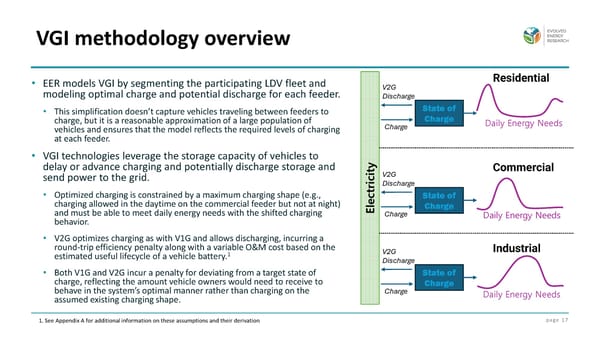page 17 • EER models VGI by segmenting the participating LDV fleet and modeling optimal charge and potential discharge for each feeder. • This simplification doesn’t capture vehicles traveling between feeders to charge, but it is a reasonable approximation of a large population of vehicles and ensures that the model reflects the required levels of charging at each feeder. • VGI technologies leverage the storage capacity of vehicles to delay or advance charging and potentially discharge storage and send power to the grid. • Optimized charging is constrained by a maximum charging shape (e.g., charging allowed in the daytime on the commercial feeder but not at night) and must be able to meet daily energy needs with the shifted charging behavior. • V2G optimizes charging as with V1G and allows discharging, incurring a round-trip efficiency penalty along with a variable O&M cost based on the estimated useful lifecycle of a vehicle battery.1 • Both V1G and V2G incur a penalty for deviating from a target state of charge, reflecting the amount vehicle owners would need to receive to behave in the system’s optimal manner rather than charging on the assumed existing charging shape. VGI methodology overview State of Charge Charge V2G Discharge Electricity Residential Daily Energy Needs Commercial Industrial State of Charge Charge V2G Discharge State of Charge Charge V2G Discharge Daily Energy Needs Daily Energy Needs 1. See Appendix A for additional information on these assumptions and their derivation
 Exploring the Value of Vehicle to Grid (V2G) for California Page 16 Page 18
Exploring the Value of Vehicle to Grid (V2G) for California Page 16 Page 18